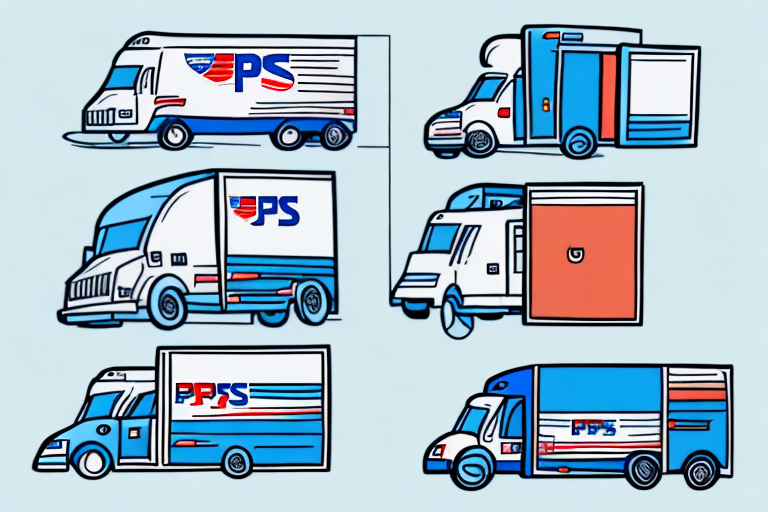Understanding the Differences Between USPS and UPS
When it comes to shipping products to customers, choosing between the United States Postal Service (USPS) and United Parcel Service (UPS) can significantly impact your business’s efficiency and costs. USPS is a government-operated entity providing mail and package delivery services across the United States, including the exclusive right to deliver to PO boxes. In contrast, UPS, a global private company, offers a broader range of delivery options, including air, ground, and freight services.
Pricing Structures: USPS utilizes a flat-rate shipping model, particularly advantageous for smaller packages. According to the USPS pricing guide, Flat Rate boxes can offer significant savings for shipping heavy items within a fixed rate. In comparison, UPS’s pricing is determined by package weight, size, and destination, which may result in higher costs for lighter packages but offer savings for larger or heavier items.
Delivery Times: Typically, USPS delivers domestic packages within 2-3 business days. UPS provides multiple delivery options such as Next-Day Air, 2nd Day Air, and 3-Day Select services, allowing for more flexibility based on package destination and urgency. Data from the UPS service guarantees highlight their commitment to varied delivery timelines tailored to business needs.
Shipping Rates: How USPS and UPS Compare
Shipping rates between USPS and UPS can vary significantly based on package size, weight, and destination. USPS generally offers lower rates for small, lightweight packages, especially with their First-Class Mail and Priority Mail services. For example, a small flat-rate box from USPS costs a flat rate regardless of weight, which is ideal for many e-commerce businesses.
UPS tends to offer better rates for larger, heavier packages, particularly through their UPS Ground service. Businesses shipping in bulk or heavier items may find UPS more cost-effective due to their volume discounts and negotiated rates.
Additionally, destination plays a crucial role. USPS's extensive network makes it particularly cost-effective for shipping to rural areas or PO boxes, whereas UPS’s comprehensive international services may offer better rates and options for global shipping needs.
Domestic Shipping: Which Carrier Offers Better Services?
For domestic shipping, both USPS and UPS provide a variety of services, but they cater to different needs. USPS is often cheaper for smaller packages and is the only carrier that can deliver to PO Boxes, which is beneficial for reaching customers without a physical address. Services like Priority Mail offer 2-3 day delivery with tracking included.
UPS offers a wider range of service options, including expedited delivery times such as Next-Day Air. Their tracking system is more detailed, providing real-time updates and estimated delivery times, as outlined in their tracking services.
Moreover, UPS provides advanced shipping solutions like UPS My Choice and UPS Quantum View, which offer enhanced visibility and control over shipments, appealing to businesses that require robust logistics management.
International Shipping: Which Carrier Has Better Reach?
When it comes to international shipping, UPS has a clear advantage with its extensive global network, covering over 220 countries and territories. UPS offers a variety of international services, including Worldwide Express and Worldwide Expedited, which provide fast and reliable international delivery options.
USPS also offers international shipping through services like Global Express Guaranteed, which provides tracking and guaranteed delivery times. While USPS is generally more affordable for international shipments, UPS offers more comprehensive services for customs clearance and international logistics.
Businesses should consider their specific international shipping needs, such as delivery speed, package size, and destination, when choosing between USPS and UPS. According to the UPS freight international report, UPS provides superior handling for larger shipments and offers tailored solutions for complex international logistics.
Tracking Capabilities: Which Carrier Offers Better Visibility?
Effective tracking is crucial for businesses to monitor shipments and provide customers with accurate delivery information. UPS excels in this area by offering comprehensive tracking services that include real-time package location, estimated delivery times, and status updates through their UPS tracking portal.
USPS also provides tracking services, particularly with their Priority Mail and Priority Mail Express services. While USPS tracking is reliable, it offers less detailed information compared to UPS, often providing updates at key points rather than continuous real-time tracking.
For businesses requiring granular tracking data, UPS's advanced tracking solutions like UPS Visibility provide enhanced monitoring and management tools, integrating seamlessly with e-commerce platforms to streamline order fulfillment processes.
Delivery Speed: Which Carrier Has Faster Delivery Times?
Delivery speed can be a decisive factor for businesses, especially those operating in fast-paced e-commerce environments. UPS generally offers faster delivery times, particularly for urgent shipments. Services like Next-Day Air ensure overnight delivery, which is ideal for time-sensitive orders.
USPS provides competitive delivery speeds with services like Priority Mail Express, which offers overnight delivery to most U.S. locations. However, USPS typically takes 2-3 business days for standard Priority Mail deliveries, which may be slower compared to equivalent UPS services.
It's important to note that delivery times can vary based on the selected service and destination. Businesses should evaluate their delivery requirements and choose the service that best aligns with their operational needs and customer expectations.
Customer Service: Which Carrier Provides Better Support?
Reliable customer service is essential for resolving shipping issues and maintaining customer satisfaction. UPS is renowned for its excellent customer service, offering dedicated support teams, comprehensive online resources, and proactive problem-solving through services like UPS Customer Support.
USPS also provides customer support through various channels, including online resources and a dedicated customer service line. While USPS customer service is generally effective for routine inquiries, it may lack the specialized support offered by UPS for complex shipping issues.
For international shipping, UPS provides expert assistance with customs regulations and international logistics, making it a preferable choice for businesses with significant overseas operations. In contrast, USPS offers more limited international support, which might be sufficient for businesses with less intensive international shipping needs.
Packaging Options: Which Carrier Offers More Flexibility?
Packaging flexibility can influence shipping efficiency and costs. USPS offers a variety of free shipping boxes and envelopes, including flat-rate options that simplify the shipping process and reduce packaging costs. Businesses can order these supplies online or pick them up at any USPS location.
UPS provides a wide range of packaging options as well, including custom packaging services for businesses with unique shipping requirements. UPS's packaging services cater to specialized needs, such as hazardous materials or oversized shipments.
Regarding size and weight restrictions, USPS allows packages up to 70 pounds and 130 inches in combined length and girth. UPS accommodates larger packages, handling shipments up to 150 pounds and 165 inches in combined length and girth. Businesses shipping large or heavy items may find UPS's higher limits more accommodating.
Insurance Coverage: Comparing USPS and UPS Policies
Insurance coverage is vital for protecting valuable shipments against loss or damage. USPS includes free insurance for Priority Mail shipments up to $100. Additional coverage can be purchased for higher-value items, though coverage options are somewhat limited compared to UPS.
UPS offers more extensive insurance options, with standard coverage up to $100 included in the shipping cost and the ability to purchase additional coverage through their UPS Insurance program. This flexibility allows businesses to insure shipments according to their specific value and risk requirements.
Regarding the claims process, USPS requires claims to be filed within 60 days of the shipment date, with the process taking up to 30 days to resolve. UPS allows claims to be filed up to 9 months after shipment, typically resolving them within 5-10 business days. UPS’s more flexible and faster claims process may be advantageous for businesses needing quick resolutions.
Both carriers have restrictions on insuring certain items, such as jewelry, precious metals, and cash. Businesses should review each carrier’s insurance policies to ensure their goods are adequately protected and consider additional insurance if necessary.
Environmental Impact: How Do USPS and UPS Compare?
Environmental sustainability is increasingly important for businesses and consumers alike. Both USPS and UPS have implemented initiatives to reduce their environmental footprint. USPS has deployed a larger fleet of alternative fuel vehicles and invested in energy-efficient facilities, as detailed in their Environmental Strategy.
UPS has committed to significant sustainability goals, including achieving carbon neutrality by 2050. Their initiatives include using electric vehicles, optimizing delivery routes for fuel efficiency, and investing in sustainable packaging materials. More information can be found in UPS’s Sustainability Report.
USPS generally has a slight edge in environmental efforts due to its scale and long-term investments in sustainable practices. However, UPS’s aggressive sustainability goals and innovative solutions also make it a strong contender for businesses prioritizing environmental responsibility.
Choosing the Right Carrier for Your Business Needs
Ultimately, the choice between USPS and UPS depends on your specific business needs and priorities. Consider the following factors when making your decision:
- Shipping Volume and Package Size: USPS is ideal for small to medium-sized packages, while UPS excels with larger, heavier shipments.
- Delivery Speed: UPS offers faster and more flexible delivery options, beneficial for businesses requiring quick turnaround times.
- Destination: USPS’s extensive local network makes it suitable for reaching rural areas and PO boxes, whereas UPS’s global reach is preferable for international shipping.
- Cost Efficiency: For businesses shipping numerous small packages, USPS’s flat-rate options can offer significant savings. Conversely, UPS may provide better rates for bulk or heavy shipments.
- Tracking and Customer Service: UPS offers more detailed tracking and superior customer service, which can enhance customer satisfaction and operational efficiency.
- Environmental Considerations: Both carriers are committed to sustainability, but USPS’s larger scale initiatives may better align with businesses prioritizing environmental impact.
By evaluating these factors, you can determine which carrier aligns best with your business operations and customer expectations, ultimately optimizing your shipping strategy and enhancing your bottom line.
Advantages and Disadvantages of Using USPS and UPS
Here's a quick rundown of the advantages and disadvantages of using USPS and UPS:
- USPS Advantages:
- Lower rates for smaller packages
- Priority Mail offers faster delivery times
- Free packaging supplies
- Delivery to PO Boxes
- Extensive local and rural delivery network
- USPS Disadvantages:
- Limited tracking information compared to UPS
- Slower delivery times for standard services
- Limited international shipping options
- UPS Advantages:
- Faster delivery times, especially for urgent shipments
- Real-time and detailed tracking information
- Wider range of service options, including international services
- Excellent customer service with specialized support
- Advanced shipping solutions and logistics management tools
- UPS Disadvantages:
- Higher rates for smaller packages
- Limited free packaging supplies
- Cannot deliver to PO Boxes
- Potentially more complex pricing structure
Case Studies: Businesses That Have Switched from USPS to UPS (or Vice Versa)
Examining real-world scenarios can provide insights into the decision-making process for businesses selecting between USPS and UPS:
- Small E-commerce Business: An online retailer shipping primarily small packages found USPS to be more cost-effective due to the availability of free packaging supplies and flat-rate options, reducing overall shipping costs.
- Manufacturing Company: A manufacturer dealing with large, heavy shipments, especially internationally, opted for UPS for its superior handling of bulky items and extensive global network, ensuring faster delivery times and reliable customs clearance.
- Subscription Box Service: A subscription-based business frequently shipping to PO Boxes chose USPS as it is the only carrier capable of delivering to PO Boxes, ensuring consistent delivery to all customers.
- Green Tech Startup: A startup focused on sustainability and environmental responsibility switched to USPS, leveraging their investments in alternative fuel vehicles and sustainable practices to align with the company's eco-friendly values.
Conclusion: Which Carrier Is the Best Option for You?
Both USPS and UPS offer robust shipping solutions with unique advantages and drawbacks. When choosing the right carrier for your business, consider the following:
- Shipping Rates: USPS is generally more affordable for smaller, lightweight packages, while UPS offers competitive rates for larger, heavier shipments.
- Delivery Options: UPS provides faster and more flexible delivery services, which is crucial for businesses that need quick turnaround times. USPS offers reliable standard shipping with the added benefit of PO Box deliveries.
- Tracking and Customer Service: UPS excels in detailed tracking and superior customer support, enhancing overall shipping reliability and customer satisfaction.
- International Shipping: For businesses with significant international shipping needs, UPS’s global network and comprehensive services provide a distinct advantage over USPS.
- Packaging Solutions: USPS’s free packaging supplies can reduce shipping costs for businesses that ship frequently, whereas UPS’s custom packaging services cater to specialized shipping requirements.
- Environmental Impact: Both carriers are committed to sustainability, but USPS’s large-scale environmental initiatives may better support businesses prioritizing eco-friendly practices.
By carefully evaluating these factors against your business’s specific needs and priorities, you can select the carrier that optimizes your shipping operations, enhances customer satisfaction, and ultimately contributes to your business’s success.






















